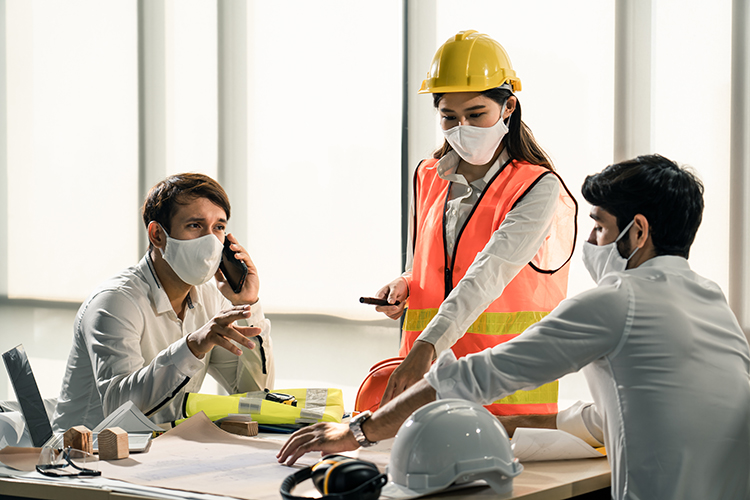
Safety First: Limiting COVID-19’s Impact on Construction Work
As the novel coronavirus (COVID-19) spread throughout the country this March and April, many states restricted the movement of residents while allowing those in “essential” businesses to continue working. Generally, construction companies have been deemed essential for this purpose — leaving contractors to grapple with the logistics.
Although nothing is certain at this point, some standard COVID-19 operating procedures have been established by American General Contractors (AGC), one of the construction industry’s leading associations. Here’s an overview of what you can do to keep workers and others safe in the current hazardous environment.
General Policies and Practices
First and foremost, if someone on your job site or in your office — whether a manager, worker or visitor — shows COVID-19 symptoms, that person should be sent home immediately. But hopefully, you won’t have to deal with that situation.
To keep employees safe from infection, they should work at least six feet apart and meetings should be limited to a maximum of ten people. Limit or eliminate many face-to-face meetings by using electronic devices or phones and allow only necessary employees to enter trailers. Also, stagger breaks and lunches to avoid close contact among crew members.
You might also want to consider dividing crews into two groups so that even if one team is required to quarantine, the other team can continue the work. These teams should work separately during the job’s duration. Be sure to use discretion when substituting workers or allowing workers to change teams.
If access to running water onsite is impracticable, provide your crews with alcohol-based hand sanitizers or disinfectant wipes. Workers should use these cleaning products on tools they share. Follow the tool manufacturers’ recommendations for proper cleaning techniques. Finally, encourage workers to wear facial masks. Because N95 respirators are in short supply, try to limit practices that produce heavy dust.
Field Specifics
Those are general outlines for construction work safety during the COVID-19 pandemic. Now let’s dig deeper into specific AGC-recommended practices.
Transportation. Discourage ridesharing to job sites, but if workers must share a vehicle, ensure adequate ventilation. And, if possible, assign crew members to drive the same truck or piece of equipment. Clean the interior thoroughly before switching operators.
Occupied buildings. Homes and other occupied structures present unique challenges. You should discuss and evaluate the risks with the building’s owner before starting the job. Have workers sanitize work areas upon arrival, throughout the day and immediately before they leave for the day. They should also wash or sanitize hands immediately before and after work.
Job site visitors. Allow visitors to the job site only when necessary. Before they enter a work area, ask a series of screening questions:
- Have you tested positive for COVID-19?
- Are you currently experiencing any respiratory illness symptoms such as cough, shortness of breath or fever?
- Have you been in close contact with anyone who has tested positive for COVID-19?
- Have you recently traveled abroad?
- Have you been in close contact with anyone who has recently traveled abroad and is also exhibiting respiratory illness symptoms?
If a visitor answers “yes” to any of these questions, deny him or her access to your site.
Site deliveries. It’s OK to permit deliveries but arrange them so there’s minimal physical contact. For example, have delivery personnel remain in their vehicles while your workers unload the trucks.
Personal protective equipment. Besides providing workers with standard construction safety equipment such as hard hats and goggles, make sure they have personal protection equipment (PPE) to help guard against COVID-19. For example, even if the job doesn’t normally require gloves, distribute latex or other suitable gloves and require workers to wear them at all times on site.
N95 respirators. At this writing, the Centers for Disease Control and Prevention (CDC) hasn’t recommended that healthy people wear N95 respirators to prevent the spread of COVID-19. The CDC has said that employees should wear N95 respirators if a specific job requires it. But because N95 respirators are in high demand by health care workers and may not be easy to source, crews should:
- Wear nonmedical grade masks while working,
- Reduce dust with engineering and work practice controls — specifically, water delivery and dust collection systems.
- Limit exposure time, if possible.
- Protect nonessential workers and bystanders by isolating workers in dusty operations with a containment structure.
- Institute a rigorous maintenance program to reduce general dust levels onsite.
Adaption Is Critical
As the situation evolves, construction firms must adapt, instituting safety measures that protect workers and visitors while sustaining operations. Take the long-term approach to this ongoing pandemic.
The information contained in this post may not reflect the most current developments, as the subject matter is extremely fluid and constantly changing. Please continue to monitor Yeo & Yeo’s COVID-19 Resource Center for ongoing developments. Readers are also cautioned against taking any action based on information contained herein without first seeking professional advice.